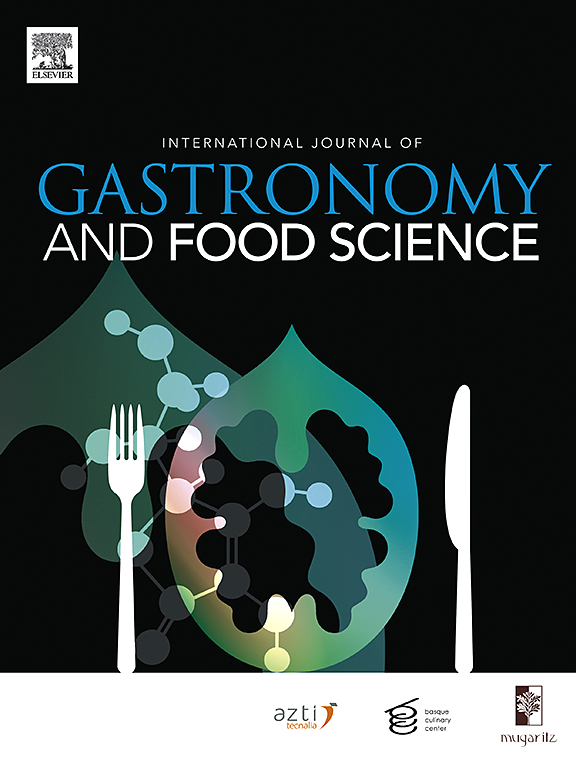Influence of Jerusalem artichoke on microbial and chemical characteristics of water kefir production
IF 3.2
2区 农林科学
Q2 FOOD SCIENCE & TECHNOLOGY
International Journal of Gastronomy and Food Science
Pub Date : 2025-01-08
DOI:10.1016/j.ijgfs.2025.101104
引用次数: 0
Abstract
The objective of this study is to assess the microbiological, chemical, and sensory attributes of Jerusalem artichoke (JA) based water kefir, a novel formulation aimed at producing a synbiotic beverage. The addition of JA resulted in an initial pH of 7.14, which decreased to 3.59 after 36 h of fermentation, compared to a decrease from 7.51 to 5.28 in the control sample. Similarly, the titratable acidity increased to 0.89 g/L in the JA-based sample versus 0.62 g/L in the control, with no statistically significant difference observed in the acidification rate (p > 0.05). The JA-based water kefir exhibited significantly higher LAB populations, with Lactobacillus sp. and Lactococcus sp. counts reaching 8.52 log CFU/mL and 7.14 log CFU/mL, respectively, compared to 5.65 log CFU/mL and 5.57 log CFU/mL in the control. DGGE analysis confirmed this trend by revealing a more diverse LAB community in the JA-based sample at the end of fermentation. Notably, Leuconostoc mesenteroides emerged as the dominant LAB species in JA-based water kefir, representing approximately 65% of the LAB population at the end of fermentation, with its count reaching 5.54 log CFU/mL out of the total 8.52 log CFU/mL for Lactobacillus sp. Regarding chemical constituents, the principal volatile compounds identified in JA-based water kefir included ethyl acetate, 3-Methyl-1-butanol, Phenethyl alcohol, nonanoic acid, capric acid, and myristic acid. Furthermore, the addition of JA to water kefir significantly increased the presence of prebiotic compounds such as inulin and fructooligosaccharides (FOS), as evidenced by the fructan content, which reached 0.546 g/100 mL during fermentation. A strong positive correlation was observed between the fructan content and LAB growth during fermentation (Pearson's r = 0.92 for Lactobacillus sp. and r = 0.89 for total LAB counts), demonstrating the impact of JA on the fermentation process and microbial proliferation. Principal Component Analysis (PCA) revealed a significant correlation between the utilization of JA as a substrate and the duration of fermentation. In conclusion, Jerusalem artichoke, with its fructan content reaching 0.546 g/100 mL, serves as a significant substrate for water kefir fermentation, enriching the beverage with inulin-type fructans and, combined with enhanced LAB proliferation, establishing its symbiotic nature.
求助全文
约1分钟内获得全文
求助全文
来源期刊

International Journal of Gastronomy and Food Science
Social Sciences-Cultural Studies
CiteScore
5.30
自引率
10.50%
发文量
170
审稿时长
45 days
期刊介绍:
International Journal of Gastronomy and Food Science is a peer-reviewed journal that explicitly focuses on the interface of food science and gastronomy. Articles focusing only on food science will not be considered. This journal equally encourages both scientists and chefs to publish original scientific papers, review articles and original culinary works. We seek articles with clear evidence of this interaction. From a scientific perspective, this publication aims to become the home for research from the whole community of food science and gastronomy.
IJGFS explores all aspects related to the growing field of the interaction of gastronomy and food science, in areas such as food chemistry, food technology and culinary techniques, food microbiology, genetics, sensory science, neuroscience, psychology, culinary concepts, culinary trends, and gastronomic experience (all the elements that contribute to the appreciation and enjoyment of the meal. Also relevant is research on science-based educational programs in gastronomy, anthropology, gastronomic history and food sociology. All these areas of knowledge are crucial to gastronomy, as they contribute to a better understanding of this broad term and its practical implications for science and society.
 求助内容:
求助内容: 应助结果提醒方式:
应助结果提醒方式:


